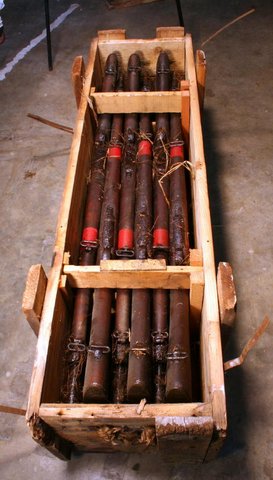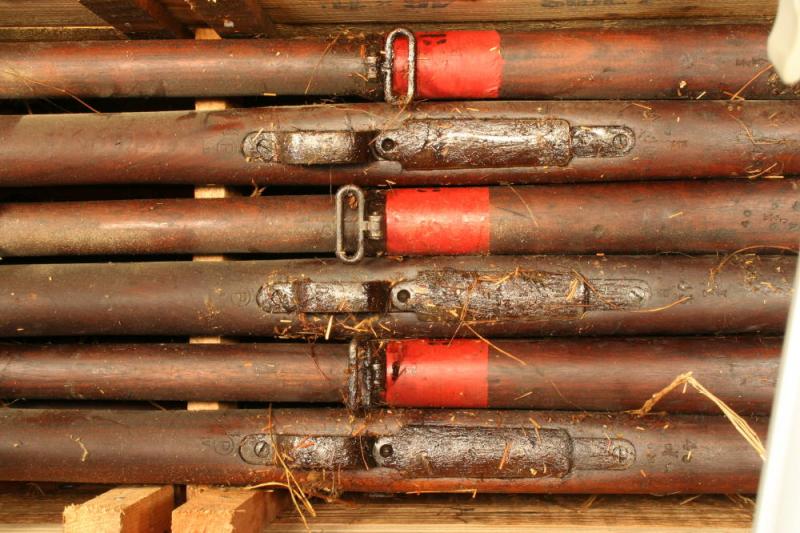-
Legacy Member

Gas escape holes
FWIW, both of these rifles have both the Hatcher hole, and smaller hole opposiite side of the receiver.
There are other original rifles with GG in the 51K range too...late, but possible.
Will e-mail you Rick...Thanks Andy
-
-
03-28-2010 08:57 PM
# ADS
Friends and Sponsors

-
Legacy Member

-
-
Legacy Member

Dirty she stays!
Just as Tommy Atkins left her when he snubbed her, when the band began to play, for her cousin the homegrown SMLE.
-
-
Advisory Panel


To Grease Or Not To Grease

Originally Posted by
Garandrew

Dirty she stays!
Just as Tommy Atkins left her when he snubbed her, when the band began to play, for her cousin the homegrown SMLE.
Andy,
Don't get too sentmentally attached to that grease...It isn't the original grease they were packed in at the factory. That grease was removed as soon as they were unpacked when they reached Britain . That's a coat of good, old, English grease and wood shavings that was slathered on the rifles, no earlier than December of 1954, when these rifles were re-packed for shipment back to the US.
. That's a coat of good, old, English grease and wood shavings that was slathered on the rifles, no earlier than December of 1954, when these rifles were re-packed for shipment back to the US.
Don't be afraid to remove the goop...In fact, I did just that with the five rifles I bought from Red Star.
Terry
-
-
Legacy Member

Terry
The reason I'm leaving the grease on the grasping groove rifle is because it proves even beyond the magazine SN list, its a LL Red Star, and unmolested since the Brits put the grease on. I know its not RA shipping cosmoline .
.
If you look at the magazine pictures of the rifles out of the crate...what you see, is what I have...it blows minds at the Big E gunshow where Ive shown it to eye popping crowds....and I was just carrying it in to show a buddy from NY who collects 03's.
I'm not selling, but I guarantee it will be more valuable in the grease,,,because buyers would anticipate what it would look like with their TLC...removing the grease.
GG rifles are much rarer....and I'm proud to have 1, plus another with non GG stock, sort of the 2 big variations...
BTW..."Modified" does not refer to non GG rifles with stamped later parts, with FJA as some suggest....I note you dont refer to them with that nomenclature anyway...
We need a book on these early RA M1903's...
They are all "Modified"...by U.S. Ordnance reference, but not officially by the U.S. or RA, just "U.S. Model M1903 Remington" from 3000,000 to 03-A3
Andy
Last edited by Garandrew; 03-31-2010 at 06:26 AM.
-
-
I don't doubt that the rifle draws attention in it's "uncleaned" state. I had several knowledgeable people suggest I leave #3024801 uncleaned but then again, my mother always said I lacked patience! 
People sleep peaceably in their beds at night only because rough men stand ready to do violence on their behalf.
--George Orwell
-
-
Advisory Panel



Originally Posted by
Garandrew

The reason I'm leaving the grease on the grasping groove rifle is because it proves even beyond the magazine SN list, its a LL Red Star, and unmolested since the Brits put the grease on. I know its not RA shipping
cosmoline
.
If you look at the magazine pictures of the rifles out of the crate...what you see, is what I have...it blows minds at the Big E gunshow where Ive shown it to eye popping crowds....and I was just carrying it in to show a buddy from NY who collects 03's.
I'm not selling, but I guarantee it will be more valuable in the grease,,,because buyers would anticipate what it would look like with their TLC...removing the grease.
GG rifles are much rarer....and I'm proud to have 1, plus another with non GG stock, sort of the 2 big variations...
BTW..."Modified" does not refer to non GG rifles with stamped later parts, with FJA as some suggest....I note you dont refer to them with that nomenclature anyway...
We need a book on these early RA M1903's...
They are all "Modified"...by U.S. Ordnance reference, but not officially by the U.S. or RA, just "U.S. Model M1903 Remington" from 3000,000 to 03-A3
Andy
Andy,
You are no doubt correct that the grease will make it more valuable to someone, but, personally, I would be a bit careful of representing the rifle as, "...unmolested since the Brits put the grease on."
Another, perhaps over-looked, value in keeping the grease on, is the fact that it covers up the dings and gouges in the stock from the more than fifty years of being thrown around by stevedores and longshoreman during its two voyages across the Atlantic, plus numerous moves across the country, while being tightly nestled against its crate-mates and separated from the row above, or below, by wooden dividers.
It is a crying shame what these beautiful rifles went through while lodged in those crates. The storage method did an excellent job of protecting the metal, but, not so great the wood. Apart from the various degrees of dings and gouges in the fore-end, of the dozens of these rifles I examined in Loren's store, every single one of them had major impressions in the butt from the front band screw of the rifle laying next to it in the crate. Some of these impressions were of such pressure that they bear the reverse image of the screw head, so the screwdriver slot in the head of the screw now protrudes.
Under some of these dents can be seen the evidence of British armorers attempts to sand out some of the dings the rifles received in their first trip across the Atlantic...Wouldn't do to issue a new rifle with fresh dents visible in the stock, now would it, old chap!
armorers attempts to sand out some of the dings the rifles received in their first trip across the Atlantic...Wouldn't do to issue a new rifle with fresh dents visible in the stock, now would it, old chap!
Perhaps there is more to be said in leaving the grease on than I first thought.
Terry
-
-
slightly ot
Just out of curiosity does anyone know for a fact how Remington packed newly produced rifles?
TM 9-1270 indicates 03's, A1'a, A3'a and A4's were packed in "containers" of 10 rifles. The same manual speaks of three grades preservatives - Oil for short term, Light preservative compound for longer term storage and Heavy preservative compound (cosmolene ?) for dead storage.
Its always seemed to me to be sort of pointless to have put rifles in cosmolene if they would be shipped right to Camp Swampy and put in the hands of new recruits who would then have to take the godawful stuff off!
On the other hand I can see that some of the crates may have gone on an ocean voyage and even been stored outside until issued. Certainly all of the rifles surplus from WW1 would have been put up in cosmo or something like it.
Also wouldn't the factory shipping crates have contained brackets or braces inside to prevent adjacent rifles from banging into each other in transit?
 Any rate if anyone knows it would be another piece of the puzzle.
Any rate if anyone knows it would be another piece of the puzzle.
Regards,
Jim
-
-
Advisory Panel


Crates
Jgaynor,
Can't really comment on Remington's shipping crates, other than to say, that judging by the evidence of old, previously sanded dings in the butts, directly under the fresher dings, I would think it quite possible that Remington packed them in a very similar fashion to that employed by the Brits when they sent them back.
The Brit method in this case, was two rows of six rifles per row, on top of each other, the two rows separated by two wooden dividers which were kept in place by slots down the sides of the crates. The six rifles in each row were arranged by alternating muzzle to butt, up and down, next to each other, with nothing but a bit of wood shavings and grease to keep them apart.
Terry
-
Thank You to Terry Hawker For This Useful Post:
-
-
Thank You to Rick the Librarian For This Useful Post:















 PM
PM













 Any rate if anyone knows it would be another piece of the puzzle.
Any rate if anyone knows it would be another piece of the puzzle.



